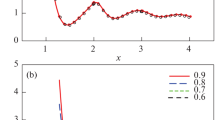Abstract
The depletion potential between two colloid particles immersed in a hydrogen bonding fluid has been investigated by density functional theory. The study is motivated by the wide applications of hydrogen bonding fluids in the field of colloid science, and the effects of relevant factors on the depletion potential and depletion force between colloid particles have been studied. These factors include the size ratio of the colloid particle to the fluid molecule, the bulk density of the fluid, the functionality (the number of proton acceptors a and proton donors d) and hydrogen bonding strength as well as the colloid-fluid interaction energy. By comparing the depletion potential calculated under various conditions, it is shown that the effects of these factors on the depletion potential are very significant, and in particular in regulating the depletion force and its range.
Similar content being viewed by others
References
Asakura S, Oosawa F. On interaction between two bodies immersed in a solution of macromolecules. J Chem Phys, 1954, 22: 1255–1256
Daoud M, Williams CE. Soft Matter Physics. Berlin Heidelberg: Springer-Verlag, 1999. 87–132
Dinsmore AD, Wong DT, Nelson P, Yodh AG. Hard spheres in vesicles: Curvature-induced forces and particle-induced curvature. Phys Rev Lett, 1998, 80: 409–412
Zaccarelli E. Colloidal gels: Equilibrium and non-equilibrium routes. J Phys: Condens Matter, 2007, 19: 323101
Yethiraj A. Tunable colloids: Control of colloidal phase transitions with tunable interactions. Soft Matter, 2007, 3: 1099–1115
Hiemenz PC, Rajagopalan R. Principles of Colloid and Surface Chemistry. New York: Marcel Dekker Inc, 1997. 355–399
Myers D. Surfaces, Interfaces, and Colloids: Principles and Applications. New York: Wiley-VCH, 1999. 214–252
Ben-Naim A. Molecular Theory of Water and Aqueous Solutions. Part I: Understanding Water. Singapore: World Scientific Publishing, 2009. 426–458
Crocker JC, Matteo JA, Dinamore AD, Yodh AG. Entropic attraction and repulsion in binary colloids probed with a line optical tweezer. Phys Rev Lett, 1999, 82: 4352–4355
Brunner M, Dobnikar J, von Grünberg HH. Direct measurement of three-body interactions amongst charged colloids. Phys Rev Lett, 2004, 92: 078301
Jiang HR, Wada H, Yoshinaga N, Sano M. Manipulation of colloids by a nonequilibrium depletion force in a temperature gradient. Phys Rev Lett, 2009, 102: 208301
Royall CP, Louis AA, Tanaka H. Measuring colloidal interactions with confocal microscopy. J Chem Phys, 2007, 127: 044507
Huang F, Addas K, Ward A, Flynn NT, Velasco E, Hagan MF, Dogic Z, Fraden S. Pair potential of charged colloidal stars. Phys Rev Lett, 2009, 102: 108302
Biancaniello PL, Anthony JK, Crocker JC. Colloidal interactions and self-assembly using DNA hybridization. Phys Rev Lett, 2005, 94: 058302
Kleshchanok D, Tuinier R, Lang PR. Direct measurements of polymer-induced forces. J Phys: Condens Matter, 2008, 20: 073101
Owen RJ, Crocker JC, Verma R, Yodh AG. Measurement of long-range steric repulsions between microspheres due to an adsorbed polymer. Phys Rev E, 2001, 64: 011401
Biben T, Bladon P, Frenkel D. Depletion effects in binary hard-sphere fluids. J Phys: Condens Matter, 1996, 8: 10799–10821
Dickman R, Attard P, Simonian V. Entropic forces in binary hard sphere mixtures: Theory and simulation. J Chem Phys, 1997, 107: 205–213
Li WH, Ma HR. Depletion potential near curved surfaces. Phys Rev E, 2002, 66: 061407
Attard P. Spherically inhomogeneous fluids. II. Hard-sphere solute in a hard-sphere solvent. J Chem Phys, 1989, 91: 3083–3089
Dzubiella J, Löwen H, Likos CN. Depletion forces in nonequilibrium. Phys Rev Lett, 2003, 91: 248301
von Grünberg HH, Klein R. Density functional theory of nonuniform colloidal suspensions: 3D density distributions and depletion forces. J Chem Phys, 1999, 110: 5421–5431
Götzelmann B, Evans R, Dietrich S. Depletion forces in fluids. Phys Rev E, 1998, 57: 6785–6800
Melchionna S, Hansen JP. Triplet depletion forces from density functional optimization. Phys Chem Chem Phys, 2000, 2: 3465–3471
Goulding D, Melchionna S. Accurate calculation of three-body depletion interactions. Phys Rev E, 2001, 64: 011403
Roth R, Evans R, Dietrich S. Depletion potential in hard-sphere mixtures: Theory and applications. Phys Rev E, 2000, 62: 5360–5377
Coleman MM, Painter PC. Hydrogen bonded polymer blends. Prog Polym Sci, 1995, 20: 1–59
Wang LY, Cui SX, Wang ZQ, Zhang X, Jiang M, Chi LF, Fuchs H. Multilayer assemblies of copolymer PSOH and PVP on the basis of hydrogen bonding. Langmuir, 2000, 16: 10490–10494
Jeffrey GA. An Introduction to Hydrogen Bonding. Oxford: Oxford University Press, 1997. 184–202
Wang HJ, Hong XZ, Ba XW. Sol-gel transition in nonlinear hydro gen bonding solutions. Macromolecules, 2007, 40: 5593–5598
Panayiotou C, Sanchez IC. Hydrogen bonding in fluids: An equation-of-state approach. J Phys Chem, 1991, 95: 10090–10097
Wang HJ, Hong XZ, Gu F, Ba XW. Statistical theory for hydrogen bonding fluid system of AaDd type (I): The geometrical phase transition. Sci China Chem, 2006, 49: 499–506
Evans R. The nature of the liquid-vapour interface and other topics in the statistical mechanics of non-uniform, classical fluids. Adv Phys, 1979, 28: 143–200
Ramakrishnan TV, Yussouff M. First-principles order-parameter theory of freezing. Phys Rev B, 1979, 19: 2775–2794
Rosenfeld Y. Free-energy model for the inhomogeneous hard-sphere fluid mixture and density-functional theory of freezing. Phys Rev Lett, 1989, 63: 980–983
Yu YX, Wu JZ. Structures of hard-sphere fluids from a modified fundamental-measure theory. J Chem Phys, 2002, 117: 10156–10164
Roth R, Evans R, Lang A, Kahl G. Fundamental measure theory for hard-sphere mixtures revisited: The White Bear version. J Phys: Condens Matter, 2002, 14: 12063–12078
Yu YX, Wu JZ. A fundamental-measure theory for inhomogeneous associating fluids. J Chem Phys, 2002, 116: 7094–7103
Carnahan NF, Starling KE. Equation of state for nonattracting rigid spheres. J Chem Phys, 1969, 51: 635–636
Segura CJ, Chapman WG, Shukla KP. Associating fluids with four bonding sites against a hard wall: Density functional theory. Mol Phys, 1997, 90: 759–771
Author information
Authors and Affiliations
Rights and permissions
About this article
Cite this article
Gu, F., Wang, H. & Li, J. Statistical theory for a hydrogen bonding fluid system of A a D d type (IV): Depletion potential between colloid particles. Sci. China Chem. 55, 1160–1166 (2012). https://doi.org/10.1007/s11426-012-4608-8
Received:
Accepted:
Published:
Issue Date:
DOI: https://doi.org/10.1007/s11426-012-4608-8




